2025年高考英语语法专题 课件 时态、语态和主谓一致
文档属性
| 名称 | 2025年高考英语语法专题 课件 时态、语态和主谓一致 |  | |
| 格式 | pptx | ||
| 文件大小 | 340.2KB | ||
| 资源类型 | 试卷 | ||
| 版本资源 | 通用版 | ||
| 科目 | 英语 | ||
| 更新时间 | 2024-12-05 09:03:20 | ||
图片预览

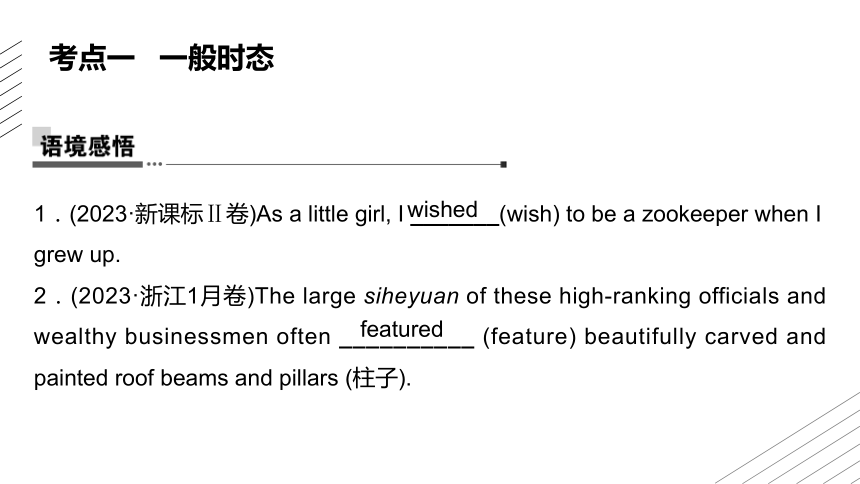
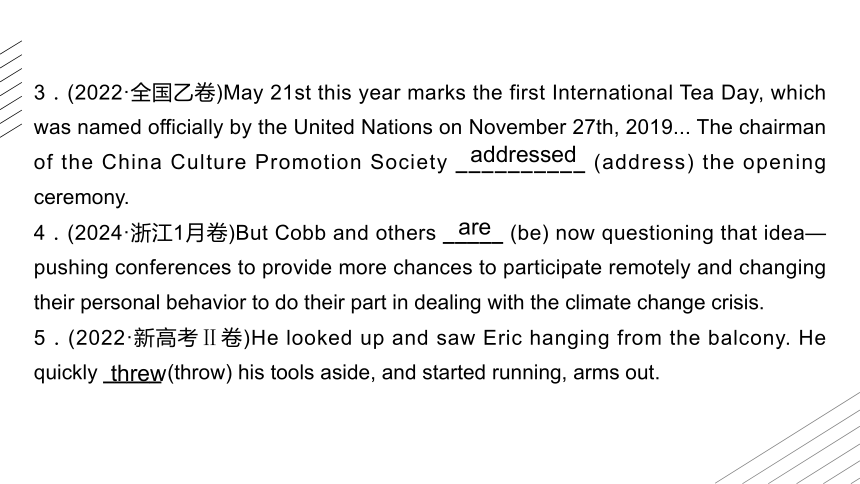

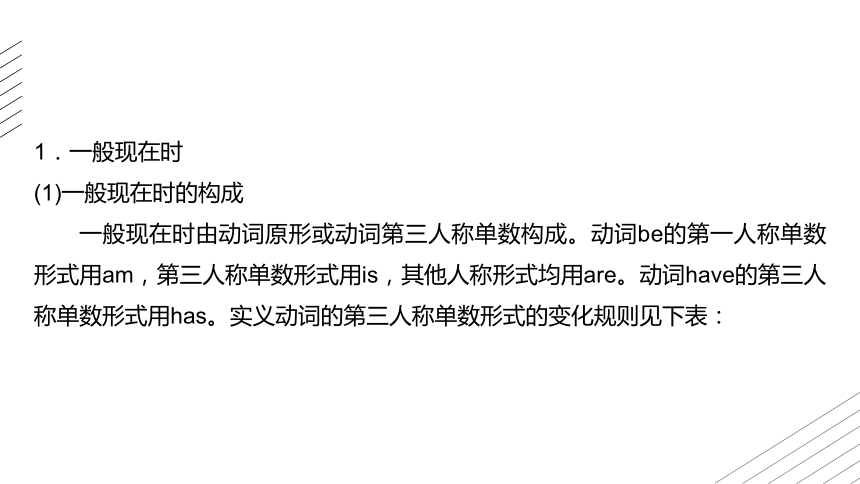
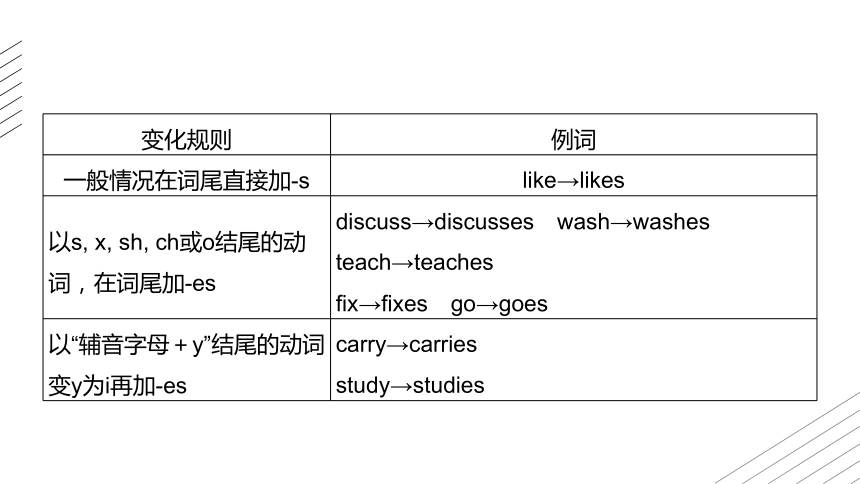
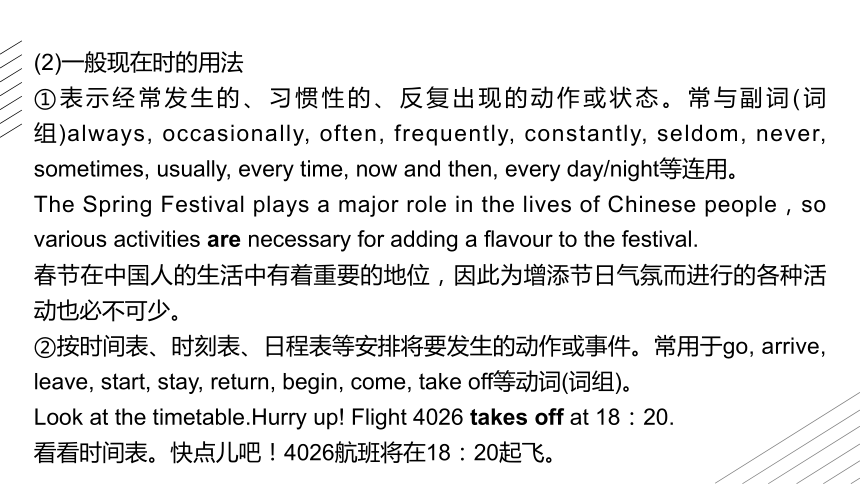
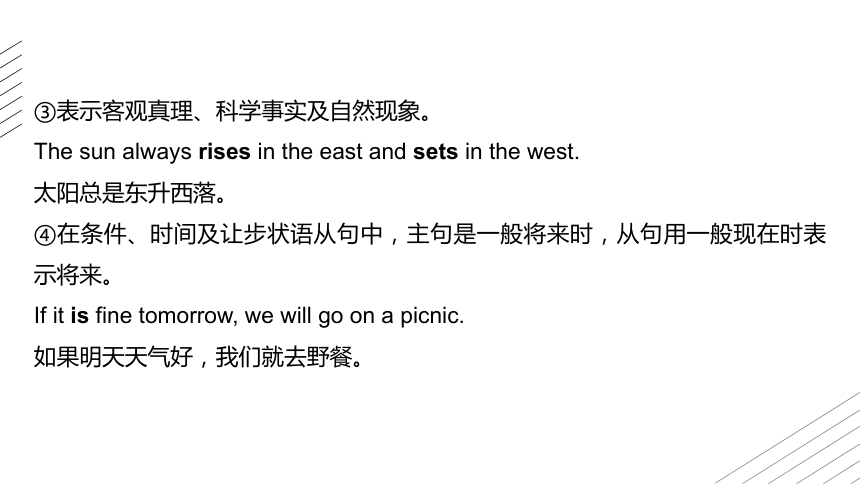
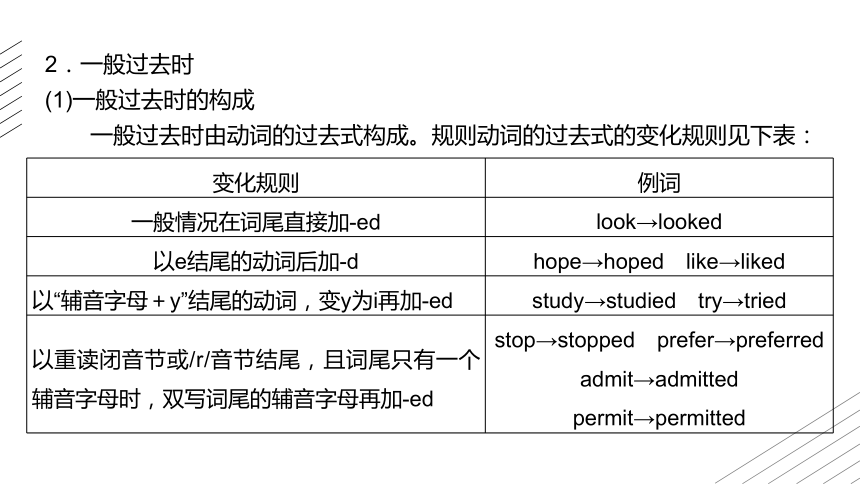
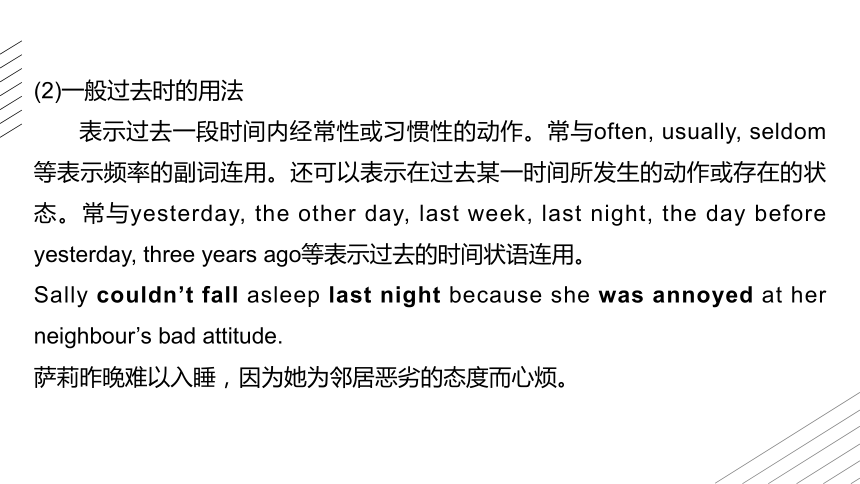
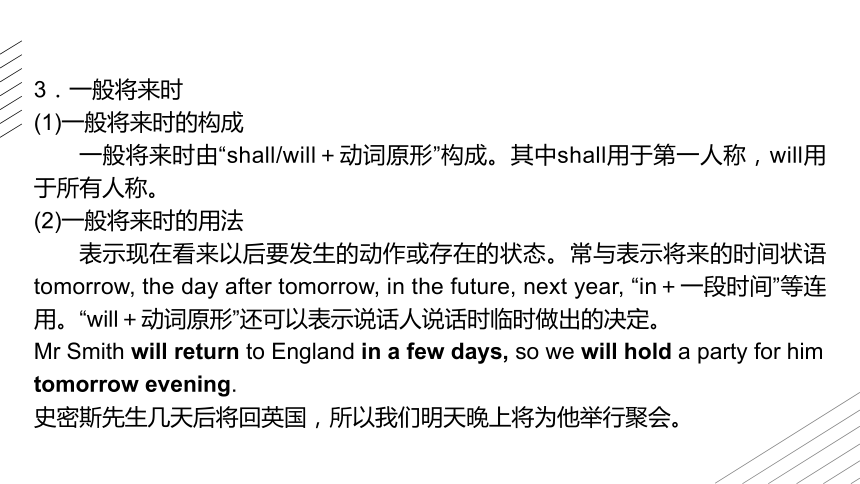
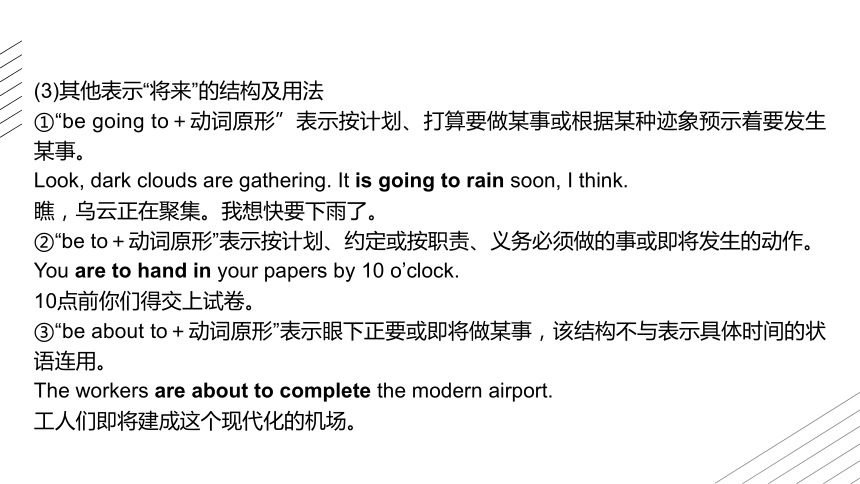
文档简介
(共51张PPT)
板块一 动词
时态、语态和主谓一致
2025年高考英语专题复习
1.(2023·新课标Ⅱ卷)As a little girl, I _______(wish) to be a zookeeper when I grew up.
2.(2023·浙江1月卷)The large siheyuan of these high-ranking officials and wealthy businessmen often __________ (feature) beautifully carved and painted roof beams and pillars (柱子).
wished
featured
考点一 一般时态
3.(2022·全国乙卷)May 21st this year marks the first International Tea Day, which was named officially by the United Nations on November 27th, 2019... The chairman of the China Culture Promotion Society __________ (address) the opening ceremony.
4.(2024·浙江1月卷)But Cobb and others _____ (be) now questioning that idea—pushing conferences to provide more chances to participate remotely and changing their personal behavior to do their part in dealing with the climate change crisis.
5.(2022·新高考Ⅱ卷)He looked up and saw Eric hanging from the balcony. He quickly _____ (throw) his tools aside, and started running, arms out.
addressed
are
threw
6.When he felt a 3D version of Leonardo da Vinci’s Mona Lisa, he _______ (notice) her smile right away. “I can actually feel what you see when you look at it,” he said.
7.We _______ (hire) our bikes from the rental place at the South Gate.My bike was old and shaky but did the job.
8.Three of the four Lincoln sons were born here. After Lincoln was elected President of the US in 1861, they rented the house and ____ (sell) most of their furniture.
noticed
hired
sold
1.一般现在时
(1)一般现在时的构成
一般现在时由动词原形或动词第三人称单数构成。动词be的第一人称单数形式用am,第三人称单数形式用is,其他人称形式均用are。动词have的第三人称单数形式用has。实义动词的第三人称单数形式的变化规则见下表:
变化规则 例词
一般情况在词尾直接加-s like→likes
以s, x, sh, ch或o结尾的动词,在词尾加-es discuss→discusses wash→washes
teach→teaches
fix→fixes go→goes
以“辅音字母+y”结尾的动词,变y为i再加-es carry→carries
study→studies
(2)一般现在时的用法
①表示经常发生的、习惯性的、反复出现的动作或状态。常与副词(词组)always, occasionally, often, frequently, constantly, seldom, never, sometimes, usually, every time, now and then, every day/night等连用。
The Spring Festival plays a major role in the lives of Chinese people,so various activities are necessary for adding a flavour to the festival.
春节在中国人的生活中有着重要的地位,因此为增添节日气氛而进行的各种活动也必不可少。
②按时间表、时刻表、日程表等安排将要发生的动作或事件。常用于go, arrive, leave, start, stay, return, begin, come, take off等动词(词组)。
Look at the timetable.Hurry up! Flight 4026 takes off at 18:20.
看看时间表。快点儿吧!4026航班将在18:20起飞。
③表示客观真理、科学事实及自然现象。
The sun always rises in the east and sets in the west.
太阳总是东升西落。
④在条件、时间及让步状语从句中,主句是一般将来时,从句用一般现在时表示将来。
If it is fine tomorrow, we will go on a picnic.
如果明天天气好,我们就去野餐。
2.一般过去时
(1)一般过去时的构成
一般过去时由动词的过去式构成。规则动词的过去式的变化规则见下表:
变化规则 例词
一般情况在词尾直接加-ed look→looked
以e结尾的动词后加-d hope→hoped like→liked
以“辅音字母+y”结尾的动词,变y为i再加-ed study→studied try→tried
以重读闭音节或/r/音节结尾,且词尾只有一个辅音字母时,双写词尾的辅音字母再加-ed stop→stopped prefer→preferred
admit→admitted permit→permitted
(2)一般过去时的用法
表示过去一段时间内经常性或习惯性的动作。常与often, usually, seldom 等表示频率的副词连用。还可以表示在过去某一时间所发生的动作或存在的状态。常与yesterday, the other day, last week, last night, the day before yesterday, three years ago等表示过去的时间状语连用。
Sally couldn’t fall asleep last night because she was annoyed at her neighbour’s bad attitude.
萨莉昨晚难以入睡,因为她为邻居恶劣的态度而心烦。
3.一般将来时
(1)一般将来时的构成
一般将来时由“shall/will+动词原形”构成。其中shall用于第一人称,will用于所有人称。
(2)一般将来时的用法
表示现在看来以后要发生的动作或存在的状态。常与表示将来的时间状语tomorrow, the day after tomorrow, in the future, next year, “in+一段时间”等连用。“will+动词原形”还可以表示说话人说话时临时做出的决定。
Mr Smith will return to England in a few days, so we will hold a party for him tomorrow evening.
史密斯先生几天后将回英国,所以我们明天晚上将为他举行聚会。
(3)其他表示“将来”的结构及用法
①“be going to+动词原形”表示按计划、打算要做某事或根据某种迹象预示着要发生某事。
Look, dark clouds are gathering. It is going to rain soon, I think.
瞧,乌云正在聚集。我想快要下雨了。
②“be to+动词原形”表示按计划、约定或按职责、义务必须做的事或即将发生的动作。
You are to hand in your papers by 10 o’clock.
10点前你们得交上试卷。
③“be about to+动词原形”表示眼下正要或即将做某事,该结构不与表示具体时间的状语连用。
The workers are about to complete the modern airport.
工人们即将建成这个现代化的机场。
如果表示从过去某时看将要发生的动作或存在的状态,要用过去将来时(would/should+动词原形)。该时态主要出现在间接引语中。
Tom told me that he would come to China for further study the next year over the phone.
汤姆在电话里告诉我,明年他将来中国进修。
考点二 进行时态
(2022·新高考Ⅱ卷)Henry ___________ (fix) his car when he heard the screams.
was fixing
1.现在进行时
(1)现在进行时的构成
现在进行时由“am/is/are+动词-ing形式”构成。动词-ing形式的变化规则见下表
变化规则 例词
一般情况在词尾直接加-ing ask→asking
以不发音的字母e结尾的动词,去e再加-ing write→writing take→taking face→facing
以重读闭音节结尾,且末尾只有一个辅音字母时,双写该辅音字母再加-ing cut→cutting begin→beginning
swim→swimming
以ie结尾的动词,变ie为y再加-ing lie→lying die→dying
(2)现在进行时的用法
①表示说话时正在进行或表示现阶段正在进行的动作,虽然此时此刻该动作不一定正在进行。现在进行时常与now, at present, right now, at this moment等时间状语连用。
At present, some scientists are developing new drugs to treat cancer.
目前,一些科学家正在研制治疗癌症的新药。
The firefighters and the volunteers are putting out the wildfire in the mountain at this moment.
此刻,消防队员和志愿者们正在扑灭山上的野火。
②表示按计划或安排即将发生的动作。常用于go, come, leave, start, arrive, return, work, sleep, stay, spend, take, play, have, wear, run out, see off, take off等动词或动词词组。
Food supplies in the flood-stricken area are running out. We must act immediately before there’s none left.
洪灾地区的食物供给即将耗尽。我们必须在食物所剩无几之前马上行动。
2.过去进行时
(1)过去进行时的构成
过去进行时由“was/were+动词-ing形式”构成。
(2)过去进行时的用法
①表示过去某一时刻或某一时间段内正在进行的动作。常与表示过去的时间状语从句以及at that time, at that moment, at this time yesterday, at ten o’clock yesterday等连用。
At this time last night, I was watching the basketball match between China and France.
昨晚的这个时候,我正在看中法两队之间的篮球赛。
②过去进行时常与when构成固定句型:was/were doing... when...,意为“正在做某事,就在这时……”。句型中的when不能换为while。
Jack was working in the lab when the power cut occurred.
杰克正在实验室里工作,就在这时停电了。
3.将来进行时
(1)将来进行时的构成
将来进行时由“will/shall+be+动词-ing形式”构成。
(2)将来进行时的用法
表示将来某一时刻或某一时间段内正在发生或进行的动作。常与一些标志性的时间状语连用,如at this time tomorrow, by then, from 1:30 to 4:30 tomorrow等。
I can’t attend the party because I will be flying to Sanya at this time tomorrow.
我无法参加那个聚会了,因为明天的这个时间我正飞往三亚。
1.(2022·全国甲卷)In the last five years, Cao ___________ (walk) through 34 countries in six continents, and in 2016, he reached the top of Kilimanjaro, Africa’s highest mountain.
2.(2022·浙江1月卷)On a website called No Fly Climate Sci, for example, roughly 200 academics—many of them climate scientists—_______________ (promise) to fly as little as possible since the effort started two years ago.
3.(2021·浙江6月卷)It doesn’t impress like George Washington’s plantation on the Potomac, but Lincoln’s home in downtown Springfield, Illinois, ____________________ (prove)irresistible to visitors since it opened to the public.
has walked
have promised
has proved/has proven
考点三 完成时态
1.现在完成时
(1)现在完成时的构成
现在完成时由“have/has+过去分词”构成。
(2)现在完成时的用法
①表示一个动作开始于过去,持续到现在(甚至到将来)。常用的时间状语:since, lately, recently, in/over/during/for the last/past few days/years, up to now, since then, ever since, in recent years, so far等。
Up to now, the team has planted more than 200,000 trees in this area.
到目前为止,该团队已经在这个地区种植了20多万棵树。
②表示过去发生的事情对现在产生的影响。常用的状语:already, ever, just (刚刚), yet等。
The concert has already started.
音乐会已经开始了。
③在条件和时间状语从句中,用现在完成时表示将来某时间前已完成的动作。
Will you come to my office when you have finished your work
你完成工作后到我办公室来一下好吗?
2.过去完成时
(1)过去完成时的构成
过去完成时由“had+过去分词”构成。
(2)过去完成时的用法
①表示在过去某一时间或某一动作之前完成的动作或存在的状态,即过去的过去。
Mary had learned some English before she came to our school.
玛丽在来我们学校前已学过一些英语了。
②表示从过去某一时间开始,一直延续到过去的另一时间的动作或状态。常用的时间状语:before, by then, by that time, by the end of, “by the time+从句”等。
By the end of last term, we had read more than 10 books written in English.
到上学期期末时,我们已经读了10多本英文书。
③表示“愿望、打算”的动词(如:hope, want, expect, think, mean, suppose, plan, intend)用于过去完成时表示过去本打算实现而未实现的愿望或计划。
I had intended to call on you yesterday, but I had an unexpected visitor.
昨天我本来打算去看你,但是来了一位不速之客。
3.常使用完成时的句型和结构
(1)This/It/That is the first/... time+that sb. has/have done sth.; This/It/That was the first/... time+that sb. had done sth.这/那是某人第一/……次做某事。
This is the first time that Peter has visited the Great Wall of China, so he looks very excited.
这是彼得第一次参观中国的长城,所以他看上去很兴奋。
It was the third time that Nancy had participated in the Olympic Games.
这是南希第三次参加奥运会了。
(2)It/This is/was the+最高级+名词+(that)定语从句,从句用完成时。
This is the best film that I have ever seen.
这是我看过的最好的电影。
(3)It is/has been+一段时间+since sb. did sth.;It was/had been+一段时间+since sb. had done sth.自从……以来多久了。
It has been three months since Miss Green came back to the US, and I miss her very much.
自从格林老师回美国以来已经三个月了,我非常想念她。
(4)hardly/scarcely... when.../no sooner... than... 一……就……,主句用过去完成时,从句用一般过去时。
Hardly/No sooner had Professor Lee finished his speech when/than he was surrounded by those enthusiastic students.
李教授一结束演讲,就被那些热情的学生包围住了。
1.现在完成进行时
(1)现在完成进行时的构成
现在完成进行时由“have/has+been+动词-ing形式”构成。
考点四 完成进行时态
(2)现在完成进行时的用法
常用来表示开始于过去某个时间、一直持续到现在并且会继续进行下去的动作。
The students have been working hard on their lessons and their efforts will be rewarded with success in the end.
学生们一直努力学习功课,他们的付出最终会获得成功的。
I have been calling him many times this morning, but there’s no answer.
今天上午我给他打了很多次电话,但没人接。
现在完成时与现在完成进行时的区别:
(1)现在完成时表示过去开始的一个动作到目前为止已经完成,体现动作的结果。
(2)现在完成进行时表示过去开始的一个动作到目前为止仍在进行,甚至仍将继续。
(3)持续性动词用于现在完成时和现在完成进行时,表达含义不同,前者重在描述客观事实,后者重在感彩的表达。
2.过去完成进行时
(1)过去完成进行时的构成
过去完成进行时由“had+been+动词-ing形式”构成。
(2)过去完成进行时的用法
过去完成进行时表示动作在过去某一时间之前开始并延续到过去某一时间。这一动作可能已经停止也可能还在进行。
She told me that she had been studying French for 5 years.
她告诉我她已经学习法语5年了。(动作仍在继续)
She told me that she had been waiting for me for an hour.
她告诉我她已经等了我一个小时。(动作不再继续)
1.(2023·全国乙卷)Having visited several times over the last 10 years, I __________ (amaze) by the co-existence of old and new, and how a city was able to keep such a rich heritage (遗产) while constantly growing.
2.(2023·全国甲卷)Carson proves that a simple literary form that has been passed down through the ages can still _____________ (employ) today to draw attention to important truths.
考点五 被动语态
was amazed
be employed
3.(2022·新高考Ⅰ卷)The GPNP _____________ (design) to reflect the guiding principle of “protecting the authenticity and integrity (完整性) of natural ecosystems, preserving biological diversity, protecting ecological buffer zones, and leaving behind precious natural assets (资产) for future generations”.
4.(2022·浙江1月卷)Travelling to conferences, lectures, workshops, and the like frequently by plane—________________________ (view) as important for scientists to get together and exchange information.
5.(2022·浙江6月卷)To understand a painting, we’re taught to look for color, composition, and light. But how can a painting ________________ (appreciate) by someone who’s blind
is designed
is viewed/has been viewed
be appreciated
6.(2021·全国甲卷)The Xi’an City Wall is the most complete city wall that has survived China’s long history. It _________ (build) originally to protect the city in the Tang dynasty and has now been completely restored (修复).
7.(2021·浙江6月卷)Mary’s niece wrote,“The little home _____________ (paint) white.”
8.(2021·浙江1月卷)It is calculated by dividing a person’s weight in kg by their height in meters squared, and a BMI of between 19 and 25 _____________ (consider) healthy.
was built
was painted
is considered
1.被动语态的构成
被动语态由“be+过去分词”构成,其中be动词有人称、数和时态的变化。被动语态的构成形式还有“get/become+过去分词”,如get paid/lost/hurt等。各种时态的被动语态形式如下表(以动词give为例):
时态 现在时 过去时 将来时 过去将来时
一般式 am given is given are given was given were given shall be given will be given should be given
would be given
进行式 am being given is being given are being given was being given were being given — —
完成式 has been given have been given had been given shall have been given will have been given should have
been given
would have
been given
2. 被动语态的用法
被动语态的使用场合:①不知道或没有必要指出动作的执行者时;②强调动作的承受者时。
As is indicated in the survey, more and more people choose to travel alone.
调查显示,越来越多的人选择独自旅行。
To make matters worse, the trees they had planted in the first two years were blown away by strong winds.
更糟糕的是,他们前两年种的树都被大风吹走了。
It is reported that a space station will be built on the moon in years to come.
据报道,在未来的几年内将在月球上建成一个空间站。
In my hometown, there is always a harvest supper for the farmers after all the wheat has been cut.
在我的家乡,当所有的麦子收割完成后,农民们总是会享受一顿丰收晚餐。
With many forests being destroyed, huge quantities of good earth are being washed away each year.
由于许多森林被毁,每年大量肥沃的泥土被冲走。
We get paid by the week.
我们按周获得薪酬。
(1)有些及物动词(短语)不能用于被动语态。常见的有:have(有), cost(花费), lack(缺少), own(拥有), belong to(属于), consist of(由……组成), take part in(参加)等。
The future belongs to the young generation, so you need to study hard now.
未来属于年轻一代,所以你现在需要努力学习。
(2)不及物动词(短语)不能用于被动语态。常见的有:happen/take place/occur/come about(发生), remain(剩下), break out(爆发), last(持续), come out(出版), come up(被提出), lose heart(失去信心), date from/back to(追溯到), run out(用完)等。
My second book came out last month.
我的第二本书上个月出版了。
3.主动形式表示被动意义
(1)“系动词(如:feel, sound, taste, look, smell, appear, seem, turn, stay, become, go, get, grow, keep等)+形容词/名词”构成系表结构,常常以主动形式表示被动意义。
This kind of wool shirt feels soft.
这种羊毛衫摸起来很软。
(2)当sell, read, cut, wash, write, open, wear, run, burn等不及物动词后有状语(well/easily等),用来表示主语内在的品质或性能时,用主动形式表示被动意义。
Have you bought the book that sells well these days I think it is very suitable for us teenagers.
你买最近销量很好的那本书了吗?我认为它非常适合我们青少年。
(3)在need, want, require, deserve等动词的后面,用动词-ing形式表示被动意义,其含义相当于动词不定式的被动形式,此时的主语常是物。
The house needs repairing/to be repaired.
这所房子需要修理。
(4)在某些“主语(人/物)+be+形容词+不定式”结构中,不定式的主动形式表示被动意义。这些形容词有:nice, easy, fit, hard, difficult, important, impossible, pleasant, interesting等。
The problem is difficult to work out.
这个问题很难解决。
(5)be to rent/blame也属于主动形式表示被动意义。
Who is to blame for the mistake
谁应该为这个错误承担责任呢?
1.(2023·全国乙卷)The remarkable development of this city, which is consciously designed to protect the past while stepping into the modern world, _______ (mean) there is always something new to discover here, and I could be photographing Beijing for the next 50 years.
2.(2023·浙江1月卷)In the Ming Dynasty, the centre was the Forbidden City, surrounded in concentric (同心的) circles by the Inner City and Outer City. Citizens of higher social classes _____________ (permit) to live closer to the centre of the circles.
means
were permitted
考点六 主谓一致
3.(2022·新高考Ⅰ卷)The plan will extend protection to a significant number of areas that ______ (be) previously unprotected, bringing many of the existing protected areas for giant pandas under one authority to increase effectiveness and reduce inconsistencies in management.
4.(2021·新高考Ⅰ卷)What comes next is the endless series of steps. You can’t help wondering how hard it _____ (be) for the people then to put all those rocks into place.
5.(2021·浙江1月卷)The study found that between 1985 and 2017, average rural BMI increased by 2.1 in women and men. In cities, however, the gain _____ (be) 1.3 in women and 1.6 in men.
were
was
was
1.语法一致原则
(1)不定式、动词-ing形式和名词性从句作主语时,谓语动词一般用单数形式;what引导的主语从句作主语时,谓语动词的单复数形式取决于作表语的名词的单复数形式。
Swimming in rivers in summer is a good sport, but to swim in rivers in winter needs great willpower.
夏天在河里游泳是很好的运动,但冬天在河里游泳需要极大的意志力。
What Professor White has said leaves much for us to think about.
怀特教授说的话发人深省。
What the children in the area starve for are books.
这个地区的孩子们急需的是书。
(2)表示时间、金钱、距离、重量等的复数名词作主语时,通常被看作整体,谓语动词用单数形式。
Three thousand dollars is quite a lot of money for a boy.
对一个男孩来说,三千美元是一笔大数目。
(3)如果主语后面带有as well as, with, along with, together with, rather than, but, except, besides, including, in addition to等加其他名词时,谓语动词的单复数形式要与前面的主语保持一致。
Modern teaching equipment as well as hundreds of computers was sent to the village school last week.
上周现代化的教学设备和几百台电脑被送到了那所乡村学校。
(4)两个名词由and连接作主语时,谓语动词一般用复数。当and不表示并列意义,连接两个在意义上表示同一人、物或概念或由两个部件配成的物品时,谓语动词用单数。
Tu Youyou and Yuan Longping are models who we should learn from.
屠呦呦和袁隆平是我们学习的榜样。
The professor and writer is speaking at the meeting.
这位教授兼作家正在会上发言。
(5)两个并列的名词有each, every, no, many a, more than one等修饰语时,谓语动词一般用单数。
Each teacher and each student has been given a new white shirt.
每个老师和学生都被给了一件新的白衬衫。
Many a boy and (many a) girl is playing on the playground.
许多男孩和女孩正在操场上玩耍。
2.意义一致原则
(1)“分数/百分数/a lot of/plenty of/the rest of/the majority of/half of/most of/some of...+名词”构成的短语作主语时,谓语动词的单复数形式由短语中的名词来确定。
The factory used three fifths of the raw materials, the rest of which were saved for other purposes.
工厂用了这种原材料的五分之三,剩余部分留作他用。
quantities of后无论是可数名词还是不可数名词,谓语动词均用复数形式。
(2)“the+形容词”表示一类人,在句中作主语时,谓语动词常用复数形式。
The young, on the one hand, often think of the old conservative. On the other hand, the old always consider the young inexperienced.
一方面,年轻人常认为老年人保守;另一方面,老年人总是认为年轻人缺乏经验。
(3)people, police, cattle等集合名词作主语时,谓语动词用复数形式;family, team, class, group, army, enemy, audience等集体名词作主语时,若指一个整体,谓语动词用单数形式;若指组成集体的成员,则用复数形式。
The family as well as their dog were trapped on the roof by the flood yesterday.
昨天那家人还有他们的狗都被洪水困在屋顶了。
(4)“a number of+名词复数”作主语时,谓语动词用复数形式,意为“许多”;“the number of+名词复数”作主语时,谓语动词用单数形式,意为“……的数量”。
The Chinese Bridge is such a beloved programme as an increasing number of foreigners have a burning desire to join in it.
《汉语桥》是一档如此受人喜爱的节目,越来越多的外国人渴望参加。
The number of the students in our school is increasing year after year.
我们学校学生的数量逐年增加。
3.就近一致原则
(1)由or, nor, either... or..., neither... nor..., not only... but also..., not... but... 等连接并列主语时,谓语动词的单复数形式常和它最接近的主语在人称和数上保持一致。
Not only John and Tom but also their younger sister, Mary, takes great interest in the piano lessons.
不仅是约翰和汤姆,就连他们的妹妹——玛丽,也对钢琴课有极大的兴趣。
(2)在倒装句中谓语动词的单复数形式常与后面最接近的主语一致。
In the distance was heard the clapping of hands and the shouts of the people.
远处传来鼓掌声和人们的喊叫声。
(3)在there be 句型中,主语是两个或多个并列名词时,be动词的形式与最接近的主语保持一致。
There are three chairs, a desk and a computer in my new office.
在我的新办公室里有三把椅子、一张桌子和一台电脑。
THANKS
板块一 动词
时态、语态和主谓一致
2025年高考英语专题复习
1.(2023·新课标Ⅱ卷)As a little girl, I _______(wish) to be a zookeeper when I grew up.
2.(2023·浙江1月卷)The large siheyuan of these high-ranking officials and wealthy businessmen often __________ (feature) beautifully carved and painted roof beams and pillars (柱子).
wished
featured
考点一 一般时态
3.(2022·全国乙卷)May 21st this year marks the first International Tea Day, which was named officially by the United Nations on November 27th, 2019... The chairman of the China Culture Promotion Society __________ (address) the opening ceremony.
4.(2024·浙江1月卷)But Cobb and others _____ (be) now questioning that idea—pushing conferences to provide more chances to participate remotely and changing their personal behavior to do their part in dealing with the climate change crisis.
5.(2022·新高考Ⅱ卷)He looked up and saw Eric hanging from the balcony. He quickly _____ (throw) his tools aside, and started running, arms out.
addressed
are
threw
6.When he felt a 3D version of Leonardo da Vinci’s Mona Lisa, he _______ (notice) her smile right away. “I can actually feel what you see when you look at it,” he said.
7.We _______ (hire) our bikes from the rental place at the South Gate.My bike was old and shaky but did the job.
8.Three of the four Lincoln sons were born here. After Lincoln was elected President of the US in 1861, they rented the house and ____ (sell) most of their furniture.
noticed
hired
sold
1.一般现在时
(1)一般现在时的构成
一般现在时由动词原形或动词第三人称单数构成。动词be的第一人称单数形式用am,第三人称单数形式用is,其他人称形式均用are。动词have的第三人称单数形式用has。实义动词的第三人称单数形式的变化规则见下表:
变化规则 例词
一般情况在词尾直接加-s like→likes
以s, x, sh, ch或o结尾的动词,在词尾加-es discuss→discusses wash→washes
teach→teaches
fix→fixes go→goes
以“辅音字母+y”结尾的动词,变y为i再加-es carry→carries
study→studies
(2)一般现在时的用法
①表示经常发生的、习惯性的、反复出现的动作或状态。常与副词(词组)always, occasionally, often, frequently, constantly, seldom, never, sometimes, usually, every time, now and then, every day/night等连用。
The Spring Festival plays a major role in the lives of Chinese people,so various activities are necessary for adding a flavour to the festival.
春节在中国人的生活中有着重要的地位,因此为增添节日气氛而进行的各种活动也必不可少。
②按时间表、时刻表、日程表等安排将要发生的动作或事件。常用于go, arrive, leave, start, stay, return, begin, come, take off等动词(词组)。
Look at the timetable.Hurry up! Flight 4026 takes off at 18:20.
看看时间表。快点儿吧!4026航班将在18:20起飞。
③表示客观真理、科学事实及自然现象。
The sun always rises in the east and sets in the west.
太阳总是东升西落。
④在条件、时间及让步状语从句中,主句是一般将来时,从句用一般现在时表示将来。
If it is fine tomorrow, we will go on a picnic.
如果明天天气好,我们就去野餐。
2.一般过去时
(1)一般过去时的构成
一般过去时由动词的过去式构成。规则动词的过去式的变化规则见下表:
变化规则 例词
一般情况在词尾直接加-ed look→looked
以e结尾的动词后加-d hope→hoped like→liked
以“辅音字母+y”结尾的动词,变y为i再加-ed study→studied try→tried
以重读闭音节或/r/音节结尾,且词尾只有一个辅音字母时,双写词尾的辅音字母再加-ed stop→stopped prefer→preferred
admit→admitted permit→permitted
(2)一般过去时的用法
表示过去一段时间内经常性或习惯性的动作。常与often, usually, seldom 等表示频率的副词连用。还可以表示在过去某一时间所发生的动作或存在的状态。常与yesterday, the other day, last week, last night, the day before yesterday, three years ago等表示过去的时间状语连用。
Sally couldn’t fall asleep last night because she was annoyed at her neighbour’s bad attitude.
萨莉昨晚难以入睡,因为她为邻居恶劣的态度而心烦。
3.一般将来时
(1)一般将来时的构成
一般将来时由“shall/will+动词原形”构成。其中shall用于第一人称,will用于所有人称。
(2)一般将来时的用法
表示现在看来以后要发生的动作或存在的状态。常与表示将来的时间状语tomorrow, the day after tomorrow, in the future, next year, “in+一段时间”等连用。“will+动词原形”还可以表示说话人说话时临时做出的决定。
Mr Smith will return to England in a few days, so we will hold a party for him tomorrow evening.
史密斯先生几天后将回英国,所以我们明天晚上将为他举行聚会。
(3)其他表示“将来”的结构及用法
①“be going to+动词原形”表示按计划、打算要做某事或根据某种迹象预示着要发生某事。
Look, dark clouds are gathering. It is going to rain soon, I think.
瞧,乌云正在聚集。我想快要下雨了。
②“be to+动词原形”表示按计划、约定或按职责、义务必须做的事或即将发生的动作。
You are to hand in your papers by 10 o’clock.
10点前你们得交上试卷。
③“be about to+动词原形”表示眼下正要或即将做某事,该结构不与表示具体时间的状语连用。
The workers are about to complete the modern airport.
工人们即将建成这个现代化的机场。
如果表示从过去某时看将要发生的动作或存在的状态,要用过去将来时(would/should+动词原形)。该时态主要出现在间接引语中。
Tom told me that he would come to China for further study the next year over the phone.
汤姆在电话里告诉我,明年他将来中国进修。
考点二 进行时态
(2022·新高考Ⅱ卷)Henry ___________ (fix) his car when he heard the screams.
was fixing
1.现在进行时
(1)现在进行时的构成
现在进行时由“am/is/are+动词-ing形式”构成。动词-ing形式的变化规则见下表
变化规则 例词
一般情况在词尾直接加-ing ask→asking
以不发音的字母e结尾的动词,去e再加-ing write→writing take→taking face→facing
以重读闭音节结尾,且末尾只有一个辅音字母时,双写该辅音字母再加-ing cut→cutting begin→beginning
swim→swimming
以ie结尾的动词,变ie为y再加-ing lie→lying die→dying
(2)现在进行时的用法
①表示说话时正在进行或表示现阶段正在进行的动作,虽然此时此刻该动作不一定正在进行。现在进行时常与now, at present, right now, at this moment等时间状语连用。
At present, some scientists are developing new drugs to treat cancer.
目前,一些科学家正在研制治疗癌症的新药。
The firefighters and the volunteers are putting out the wildfire in the mountain at this moment.
此刻,消防队员和志愿者们正在扑灭山上的野火。
②表示按计划或安排即将发生的动作。常用于go, come, leave, start, arrive, return, work, sleep, stay, spend, take, play, have, wear, run out, see off, take off等动词或动词词组。
Food supplies in the flood-stricken area are running out. We must act immediately before there’s none left.
洪灾地区的食物供给即将耗尽。我们必须在食物所剩无几之前马上行动。
2.过去进行时
(1)过去进行时的构成
过去进行时由“was/were+动词-ing形式”构成。
(2)过去进行时的用法
①表示过去某一时刻或某一时间段内正在进行的动作。常与表示过去的时间状语从句以及at that time, at that moment, at this time yesterday, at ten o’clock yesterday等连用。
At this time last night, I was watching the basketball match between China and France.
昨晚的这个时候,我正在看中法两队之间的篮球赛。
②过去进行时常与when构成固定句型:was/were doing... when...,意为“正在做某事,就在这时……”。句型中的when不能换为while。
Jack was working in the lab when the power cut occurred.
杰克正在实验室里工作,就在这时停电了。
3.将来进行时
(1)将来进行时的构成
将来进行时由“will/shall+be+动词-ing形式”构成。
(2)将来进行时的用法
表示将来某一时刻或某一时间段内正在发生或进行的动作。常与一些标志性的时间状语连用,如at this time tomorrow, by then, from 1:30 to 4:30 tomorrow等。
I can’t attend the party because I will be flying to Sanya at this time tomorrow.
我无法参加那个聚会了,因为明天的这个时间我正飞往三亚。
1.(2022·全国甲卷)In the last five years, Cao ___________ (walk) through 34 countries in six continents, and in 2016, he reached the top of Kilimanjaro, Africa’s highest mountain.
2.(2022·浙江1月卷)On a website called No Fly Climate Sci, for example, roughly 200 academics—many of them climate scientists—_______________ (promise) to fly as little as possible since the effort started two years ago.
3.(2021·浙江6月卷)It doesn’t impress like George Washington’s plantation on the Potomac, but Lincoln’s home in downtown Springfield, Illinois, ____________________ (prove)irresistible to visitors since it opened to the public.
has walked
have promised
has proved/has proven
考点三 完成时态
1.现在完成时
(1)现在完成时的构成
现在完成时由“have/has+过去分词”构成。
(2)现在完成时的用法
①表示一个动作开始于过去,持续到现在(甚至到将来)。常用的时间状语:since, lately, recently, in/over/during/for the last/past few days/years, up to now, since then, ever since, in recent years, so far等。
Up to now, the team has planted more than 200,000 trees in this area.
到目前为止,该团队已经在这个地区种植了20多万棵树。
②表示过去发生的事情对现在产生的影响。常用的状语:already, ever, just (刚刚), yet等。
The concert has already started.
音乐会已经开始了。
③在条件和时间状语从句中,用现在完成时表示将来某时间前已完成的动作。
Will you come to my office when you have finished your work
你完成工作后到我办公室来一下好吗?
2.过去完成时
(1)过去完成时的构成
过去完成时由“had+过去分词”构成。
(2)过去完成时的用法
①表示在过去某一时间或某一动作之前完成的动作或存在的状态,即过去的过去。
Mary had learned some English before she came to our school.
玛丽在来我们学校前已学过一些英语了。
②表示从过去某一时间开始,一直延续到过去的另一时间的动作或状态。常用的时间状语:before, by then, by that time, by the end of, “by the time+从句”等。
By the end of last term, we had read more than 10 books written in English.
到上学期期末时,我们已经读了10多本英文书。
③表示“愿望、打算”的动词(如:hope, want, expect, think, mean, suppose, plan, intend)用于过去完成时表示过去本打算实现而未实现的愿望或计划。
I had intended to call on you yesterday, but I had an unexpected visitor.
昨天我本来打算去看你,但是来了一位不速之客。
3.常使用完成时的句型和结构
(1)This/It/That is the first/... time+that sb. has/have done sth.; This/It/That was the first/... time+that sb. had done sth.这/那是某人第一/……次做某事。
This is the first time that Peter has visited the Great Wall of China, so he looks very excited.
这是彼得第一次参观中国的长城,所以他看上去很兴奋。
It was the third time that Nancy had participated in the Olympic Games.
这是南希第三次参加奥运会了。
(2)It/This is/was the+最高级+名词+(that)定语从句,从句用完成时。
This is the best film that I have ever seen.
这是我看过的最好的电影。
(3)It is/has been+一段时间+since sb. did sth.;It was/had been+一段时间+since sb. had done sth.自从……以来多久了。
It has been three months since Miss Green came back to the US, and I miss her very much.
自从格林老师回美国以来已经三个月了,我非常想念她。
(4)hardly/scarcely... when.../no sooner... than... 一……就……,主句用过去完成时,从句用一般过去时。
Hardly/No sooner had Professor Lee finished his speech when/than he was surrounded by those enthusiastic students.
李教授一结束演讲,就被那些热情的学生包围住了。
1.现在完成进行时
(1)现在完成进行时的构成
现在完成进行时由“have/has+been+动词-ing形式”构成。
考点四 完成进行时态
(2)现在完成进行时的用法
常用来表示开始于过去某个时间、一直持续到现在并且会继续进行下去的动作。
The students have been working hard on their lessons and their efforts will be rewarded with success in the end.
学生们一直努力学习功课,他们的付出最终会获得成功的。
I have been calling him many times this morning, but there’s no answer.
今天上午我给他打了很多次电话,但没人接。
现在完成时与现在完成进行时的区别:
(1)现在完成时表示过去开始的一个动作到目前为止已经完成,体现动作的结果。
(2)现在完成进行时表示过去开始的一个动作到目前为止仍在进行,甚至仍将继续。
(3)持续性动词用于现在完成时和现在完成进行时,表达含义不同,前者重在描述客观事实,后者重在感彩的表达。
2.过去完成进行时
(1)过去完成进行时的构成
过去完成进行时由“had+been+动词-ing形式”构成。
(2)过去完成进行时的用法
过去完成进行时表示动作在过去某一时间之前开始并延续到过去某一时间。这一动作可能已经停止也可能还在进行。
She told me that she had been studying French for 5 years.
她告诉我她已经学习法语5年了。(动作仍在继续)
She told me that she had been waiting for me for an hour.
她告诉我她已经等了我一个小时。(动作不再继续)
1.(2023·全国乙卷)Having visited several times over the last 10 years, I __________ (amaze) by the co-existence of old and new, and how a city was able to keep such a rich heritage (遗产) while constantly growing.
2.(2023·全国甲卷)Carson proves that a simple literary form that has been passed down through the ages can still _____________ (employ) today to draw attention to important truths.
考点五 被动语态
was amazed
be employed
3.(2022·新高考Ⅰ卷)The GPNP _____________ (design) to reflect the guiding principle of “protecting the authenticity and integrity (完整性) of natural ecosystems, preserving biological diversity, protecting ecological buffer zones, and leaving behind precious natural assets (资产) for future generations”.
4.(2022·浙江1月卷)Travelling to conferences, lectures, workshops, and the like frequently by plane—________________________ (view) as important for scientists to get together and exchange information.
5.(2022·浙江6月卷)To understand a painting, we’re taught to look for color, composition, and light. But how can a painting ________________ (appreciate) by someone who’s blind
is designed
is viewed/has been viewed
be appreciated
6.(2021·全国甲卷)The Xi’an City Wall is the most complete city wall that has survived China’s long history. It _________ (build) originally to protect the city in the Tang dynasty and has now been completely restored (修复).
7.(2021·浙江6月卷)Mary’s niece wrote,“The little home _____________ (paint) white.”
8.(2021·浙江1月卷)It is calculated by dividing a person’s weight in kg by their height in meters squared, and a BMI of between 19 and 25 _____________ (consider) healthy.
was built
was painted
is considered
1.被动语态的构成
被动语态由“be+过去分词”构成,其中be动词有人称、数和时态的变化。被动语态的构成形式还有“get/become+过去分词”,如get paid/lost/hurt等。各种时态的被动语态形式如下表(以动词give为例):
时态 现在时 过去时 将来时 过去将来时
一般式 am given is given are given was given were given shall be given will be given should be given
would be given
进行式 am being given is being given are being given was being given were being given — —
完成式 has been given have been given had been given shall have been given will have been given should have
been given
would have
been given
2. 被动语态的用法
被动语态的使用场合:①不知道或没有必要指出动作的执行者时;②强调动作的承受者时。
As is indicated in the survey, more and more people choose to travel alone.
调查显示,越来越多的人选择独自旅行。
To make matters worse, the trees they had planted in the first two years were blown away by strong winds.
更糟糕的是,他们前两年种的树都被大风吹走了。
It is reported that a space station will be built on the moon in years to come.
据报道,在未来的几年内将在月球上建成一个空间站。
In my hometown, there is always a harvest supper for the farmers after all the wheat has been cut.
在我的家乡,当所有的麦子收割完成后,农民们总是会享受一顿丰收晚餐。
With many forests being destroyed, huge quantities of good earth are being washed away each year.
由于许多森林被毁,每年大量肥沃的泥土被冲走。
We get paid by the week.
我们按周获得薪酬。
(1)有些及物动词(短语)不能用于被动语态。常见的有:have(有), cost(花费), lack(缺少), own(拥有), belong to(属于), consist of(由……组成), take part in(参加)等。
The future belongs to the young generation, so you need to study hard now.
未来属于年轻一代,所以你现在需要努力学习。
(2)不及物动词(短语)不能用于被动语态。常见的有:happen/take place/occur/come about(发生), remain(剩下), break out(爆发), last(持续), come out(出版), come up(被提出), lose heart(失去信心), date from/back to(追溯到), run out(用完)等。
My second book came out last month.
我的第二本书上个月出版了。
3.主动形式表示被动意义
(1)“系动词(如:feel, sound, taste, look, smell, appear, seem, turn, stay, become, go, get, grow, keep等)+形容词/名词”构成系表结构,常常以主动形式表示被动意义。
This kind of wool shirt feels soft.
这种羊毛衫摸起来很软。
(2)当sell, read, cut, wash, write, open, wear, run, burn等不及物动词后有状语(well/easily等),用来表示主语内在的品质或性能时,用主动形式表示被动意义。
Have you bought the book that sells well these days I think it is very suitable for us teenagers.
你买最近销量很好的那本书了吗?我认为它非常适合我们青少年。
(3)在need, want, require, deserve等动词的后面,用动词-ing形式表示被动意义,其含义相当于动词不定式的被动形式,此时的主语常是物。
The house needs repairing/to be repaired.
这所房子需要修理。
(4)在某些“主语(人/物)+be+形容词+不定式”结构中,不定式的主动形式表示被动意义。这些形容词有:nice, easy, fit, hard, difficult, important, impossible, pleasant, interesting等。
The problem is difficult to work out.
这个问题很难解决。
(5)be to rent/blame也属于主动形式表示被动意义。
Who is to blame for the mistake
谁应该为这个错误承担责任呢?
1.(2023·全国乙卷)The remarkable development of this city, which is consciously designed to protect the past while stepping into the modern world, _______ (mean) there is always something new to discover here, and I could be photographing Beijing for the next 50 years.
2.(2023·浙江1月卷)In the Ming Dynasty, the centre was the Forbidden City, surrounded in concentric (同心的) circles by the Inner City and Outer City. Citizens of higher social classes _____________ (permit) to live closer to the centre of the circles.
means
were permitted
考点六 主谓一致
3.(2022·新高考Ⅰ卷)The plan will extend protection to a significant number of areas that ______ (be) previously unprotected, bringing many of the existing protected areas for giant pandas under one authority to increase effectiveness and reduce inconsistencies in management.
4.(2021·新高考Ⅰ卷)What comes next is the endless series of steps. You can’t help wondering how hard it _____ (be) for the people then to put all those rocks into place.
5.(2021·浙江1月卷)The study found that between 1985 and 2017, average rural BMI increased by 2.1 in women and men. In cities, however, the gain _____ (be) 1.3 in women and 1.6 in men.
were
was
was
1.语法一致原则
(1)不定式、动词-ing形式和名词性从句作主语时,谓语动词一般用单数形式;what引导的主语从句作主语时,谓语动词的单复数形式取决于作表语的名词的单复数形式。
Swimming in rivers in summer is a good sport, but to swim in rivers in winter needs great willpower.
夏天在河里游泳是很好的运动,但冬天在河里游泳需要极大的意志力。
What Professor White has said leaves much for us to think about.
怀特教授说的话发人深省。
What the children in the area starve for are books.
这个地区的孩子们急需的是书。
(2)表示时间、金钱、距离、重量等的复数名词作主语时,通常被看作整体,谓语动词用单数形式。
Three thousand dollars is quite a lot of money for a boy.
对一个男孩来说,三千美元是一笔大数目。
(3)如果主语后面带有as well as, with, along with, together with, rather than, but, except, besides, including, in addition to等加其他名词时,谓语动词的单复数形式要与前面的主语保持一致。
Modern teaching equipment as well as hundreds of computers was sent to the village school last week.
上周现代化的教学设备和几百台电脑被送到了那所乡村学校。
(4)两个名词由and连接作主语时,谓语动词一般用复数。当and不表示并列意义,连接两个在意义上表示同一人、物或概念或由两个部件配成的物品时,谓语动词用单数。
Tu Youyou and Yuan Longping are models who we should learn from.
屠呦呦和袁隆平是我们学习的榜样。
The professor and writer is speaking at the meeting.
这位教授兼作家正在会上发言。
(5)两个并列的名词有each, every, no, many a, more than one等修饰语时,谓语动词一般用单数。
Each teacher and each student has been given a new white shirt.
每个老师和学生都被给了一件新的白衬衫。
Many a boy and (many a) girl is playing on the playground.
许多男孩和女孩正在操场上玩耍。
2.意义一致原则
(1)“分数/百分数/a lot of/plenty of/the rest of/the majority of/half of/most of/some of...+名词”构成的短语作主语时,谓语动词的单复数形式由短语中的名词来确定。
The factory used three fifths of the raw materials, the rest of which were saved for other purposes.
工厂用了这种原材料的五分之三,剩余部分留作他用。
quantities of后无论是可数名词还是不可数名词,谓语动词均用复数形式。
(2)“the+形容词”表示一类人,在句中作主语时,谓语动词常用复数形式。
The young, on the one hand, often think of the old conservative. On the other hand, the old always consider the young inexperienced.
一方面,年轻人常认为老年人保守;另一方面,老年人总是认为年轻人缺乏经验。
(3)people, police, cattle等集合名词作主语时,谓语动词用复数形式;family, team, class, group, army, enemy, audience等集体名词作主语时,若指一个整体,谓语动词用单数形式;若指组成集体的成员,则用复数形式。
The family as well as their dog were trapped on the roof by the flood yesterday.
昨天那家人还有他们的狗都被洪水困在屋顶了。
(4)“a number of+名词复数”作主语时,谓语动词用复数形式,意为“许多”;“the number of+名词复数”作主语时,谓语动词用单数形式,意为“……的数量”。
The Chinese Bridge is such a beloved programme as an increasing number of foreigners have a burning desire to join in it.
《汉语桥》是一档如此受人喜爱的节目,越来越多的外国人渴望参加。
The number of the students in our school is increasing year after year.
我们学校学生的数量逐年增加。
3.就近一致原则
(1)由or, nor, either... or..., neither... nor..., not only... but also..., not... but... 等连接并列主语时,谓语动词的单复数形式常和它最接近的主语在人称和数上保持一致。
Not only John and Tom but also their younger sister, Mary, takes great interest in the piano lessons.
不仅是约翰和汤姆,就连他们的妹妹——玛丽,也对钢琴课有极大的兴趣。
(2)在倒装句中谓语动词的单复数形式常与后面最接近的主语一致。
In the distance was heard the clapping of hands and the shouts of the people.
远处传来鼓掌声和人们的喊叫声。
(3)在there be 句型中,主语是两个或多个并列名词时,be动词的形式与最接近的主语保持一致。
There are three chairs, a desk and a computer in my new office.
在我的新办公室里有三把椅子、一张桌子和一台电脑。
THANKS
